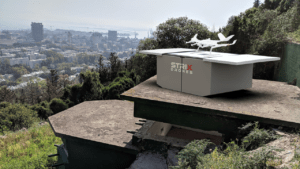
by DRONELIFE Feature Writer Jim Magill
The company had a ribbon-cutting ceremony at the plant, its first U.S.-based manufacturing facility, last month. The factory will produce two sizes of docking stations, which can be used to accommodate most commercial drones, as well as a delivery box that can securely handle drone-delivered packages, Strix CEO Niv Aharoni said in an interview.
“This is the big difference between Strix Drones and other companies. We are not drone-in-a-box. We’re the only company to provide a solution for any kind of drones,” he said.
Strix has signed contracts with other factories in the area, which will supply the docking station company with components to begin assembling its products at its Dayton plant later this year. “We will do the assembly in the U.S. and will buy all the raw materials from a contractor in the U.S.A. We would like to make the product fully in the U.S.A,” Aharoni said.
The company plans to build the machines that will allow it to fabricate the component parts of its stations on its own, within the next year. The Ohio plant will be the site for production of the Strix 1600 docking station, which houses a landing pad of 1.6 meters-by-1.6 meters (5.25-feet-by-5.24 feet), and the Strix 2100, with a 2.1-meter-by-2.1-meter (about 7-by-7 feet) landing pad.
In addition, the plant will manufacture delivery boxes that can work in concert with the docking station to accept and store packaged deliveries from almost any model of commercial drone. Aharoni said the three products are built to accommodate 80% to 90% of the commercial drones currently on the market.

Strix Drones was founded four years ago as a manufacturer of drone-related products for the military market. Based on its work producing military grade docking stations, the company has expanded to develop the products for the civilian drone market. Strix is also working with federal officials to develop docking stations for drones being used to secure the U.S.-Mexican border.
The drone agnostic docking stations are fabricated with aluminum and are specially designed to let GPS and other telecommunications signals to penetrate the doors, allowing the drone to maintain two-way communications capability while inside the unit.
Each docking unit’s X-Y centering system allows a drone to land anywhere inside the charging station. The system will then move the UAV to the center of the station where the battery charger is located for faster charging times. The docking station’s software identifies the type of drone and adapts the charger for optimal charging.
Climate controls in the unit provide the optimal conditions for battery charging, while each landing station employs a telemetric weather system to report local wind and rain conditions, which allow the drone operator to select the best time for relaunching the drone for its next mission.
The system is designed to connect to any drone’s command and control through application programming interface (API) communications. This feature allows users to link to different docking stations and to build a connected chain of stations to extend the range of the drones.
Israel Maimon, Strix head of strategy and development, said the company chose Dayton as the site of its manufacturing plant for several reasons. The city is located in the midst of Ohio’s steel-producing region, with a high concentration of manufacturing resources and expertise. The region is also home to Wright-Patterson Air Force Base, home of the 88th Air Base Wing.
Stix is also working closely with Sinclair College in Dayton, which has an extensive drone studies program, teaching students the skills needed for drone design, manufacturing, flying, and command and control. “They have a great knowhow. We are happy to collaborate with them,” Maimon said. “We will use the students and their expertise to provide service to our clients, once we will start to manufacture at a bigger scale.”
Maimon said Styx is hoping to partner with U.S. drone companies that are looking for storage and battery-charging solutions to help facilitate drone missions that stretch over long distances and extended lengths of time. At a recent border security conference in San Antonio, Texas, a number of companies inquired about the use of Strix’s products to help operators extend the range of their drones and allow for more autonomous missions, he said.
“Many of them saw a great opportunity with a docking station that will host the drone in the field rather than having someone manually operating it,” he said.
Read more features by Jim Magill:
- Spright and Wonder Robotics Team on Drone Landing Logistics for Medical Delivery
- DJI in Russia and Ukraine: Company Suspends Business as Military Use of Commercial Off the Shelf Drones Continues
- Police in North Texas Use Drones to Save Lives: Deploying Drone Clear
- Manna in the U.S.: Irish Drone Delivery Service Plans Slow Rollout this Year
- SkyeBrowse Wins DHS Grant for New Technology to Deal With School Shooters
Miriam McNabb is the Editor-in-Chief of DRONELIFE and CEO of JobForDrones, a professional drone services marketplace, and a fascinated observer of the emerging drone industry and the regulatory environment for drones. Miriam has penned over 3,000 articles focused on the commercial drone space and is an international speaker and recognized figure in the industry. Miriam has a degree from the University of Chicago and over 20 years of experience in high tech sales and marketing for new technologies.
For drone industry consulting or writing, Email Miriam.
TWITTER:@spaldingbarker
Subscribe to DroneLife here.